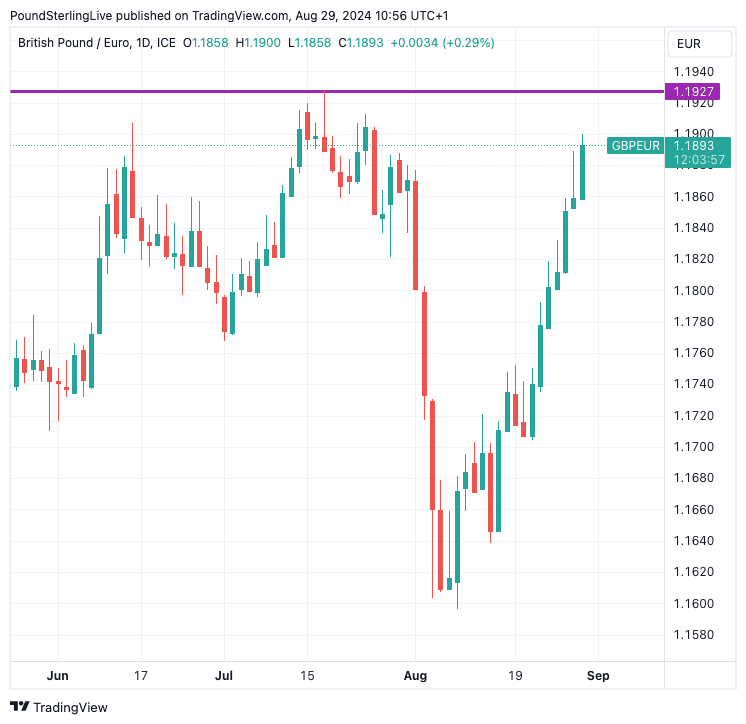GBP/EUR Makes Fresh Push Higher Following Soft German and Spanish Inflation Prints
- Written by: Gary Howes

Image © Alfred Yaghobzadeh, European Commission Audiovisual Services
The Pound to Euro exchange rate rally extends another day, with a high of 1.19 printed on Thursday and analysts now looking to the 2024 peak.
The Euro was sold after German and Spanish inflation prints undershot expectations, raising the odds of a weak all-Eurozone inflation reading on Friday that should prompt a quicker pace of interest rate cuts from the European Central Bank in the coming months.
Germany's inflation surprised to the downside, printing at 2% year-on-year in August, down from 2.6% in July and below the consensus expectation for 2.2%. Core CPI was 2.8% after 2.9% previously. Services CPI, an important metric for inflation watches, slowed notably to 0.26% month-on-month from 0.37% in July.
"Softer-than-expected inflation data today illustrate two things. First, as we have been recently flagging, the inflation concern narrative is looking likely to be behind us, and inflation is increasingly of secondary concern in the euro area. Second, it appears that tomorrow we are likely to be in for the second downside surprise of the year for euro area HICP relative to consensus," says Andrzej Szczepaniak, an analyst at Nomura.
Compare Currency Exchange Rates
Find out how much you could save on your international transfer
Estimated saving compared to high street banks:
£25.00
Free • No obligation • Takes 2 minutes
German inflation figures are released at the individual state level during the course of the morning. As a result, the foreign exchange market got a whiff that a downside surprise was in the making, sending the Euro down by half a per cent against the Dollar and a quarter of a per cent against the Pound.
Adding to Euro weakness was Spain's national figure, which also undershot, with HICP inflation reading at 0% month-on-month, taking the year-on-year figure to 2.4% from 2.9% previously. The expectation was for a fall to 2.5%. Spain is closely watched with some economists saying it tends to give insights into future European trends as the passthrough of inflation tends to be faster.
"The euro came under pressure on Thursday, dropping below $1.1100, following weaker-than-expected CPI readings from Eurozone countries reporting their numbers ahead of tomorrow’s flash estimates for the whole of the euro area," says Raffi Boyadjian, Lead Investment Analyst at XM.com.
These data underscore a constructive trend in Pound-Euro, and analysts are now locking eyes on the 2024 high at 1.1928.
"When it comes to GBPEUR, it still looks like we could see a test of the highs seen back in July," says Thanim Islam, Head of FX Analysis at Equals Money.
Another report out on Thursday showed economic sentiment in the Eurozone remained depressed in August, although the Olympics look to have provided France with a boost.
Indeed, the headline figure from the European Union's Economic Sentiment Indicator (ESI) didn't look too bad at first glance, coming in at 96.6 from 96 in July.
"The ESI for France jumped by 4.3. In contrast, the measures for Germany and Italy both fell, suggesting that the underlying situation in the euro-zone as a whole has not improved," says Andrew Kenningham, Chief Europe Economist at Capital Economics.
Softening Eurozone-wide sentiment mirrors the findings of the August PMI survey, which showed businesses are more downbeat about the outlook than they have been for some time now. The prospect of a slowing economy and falling inflation will encourage the ECB to cut rates further, which can weigh on Euro exchange rates.






